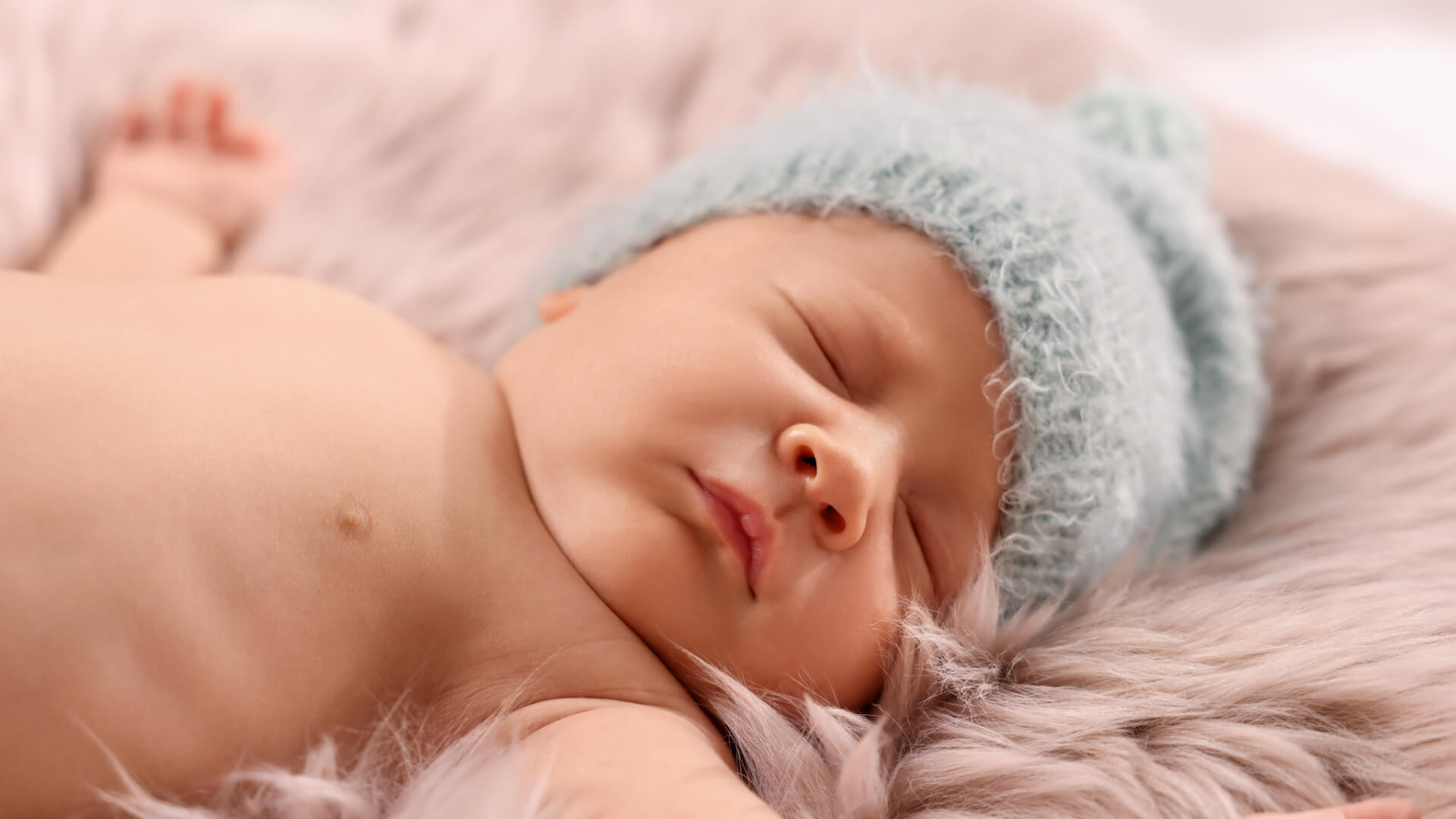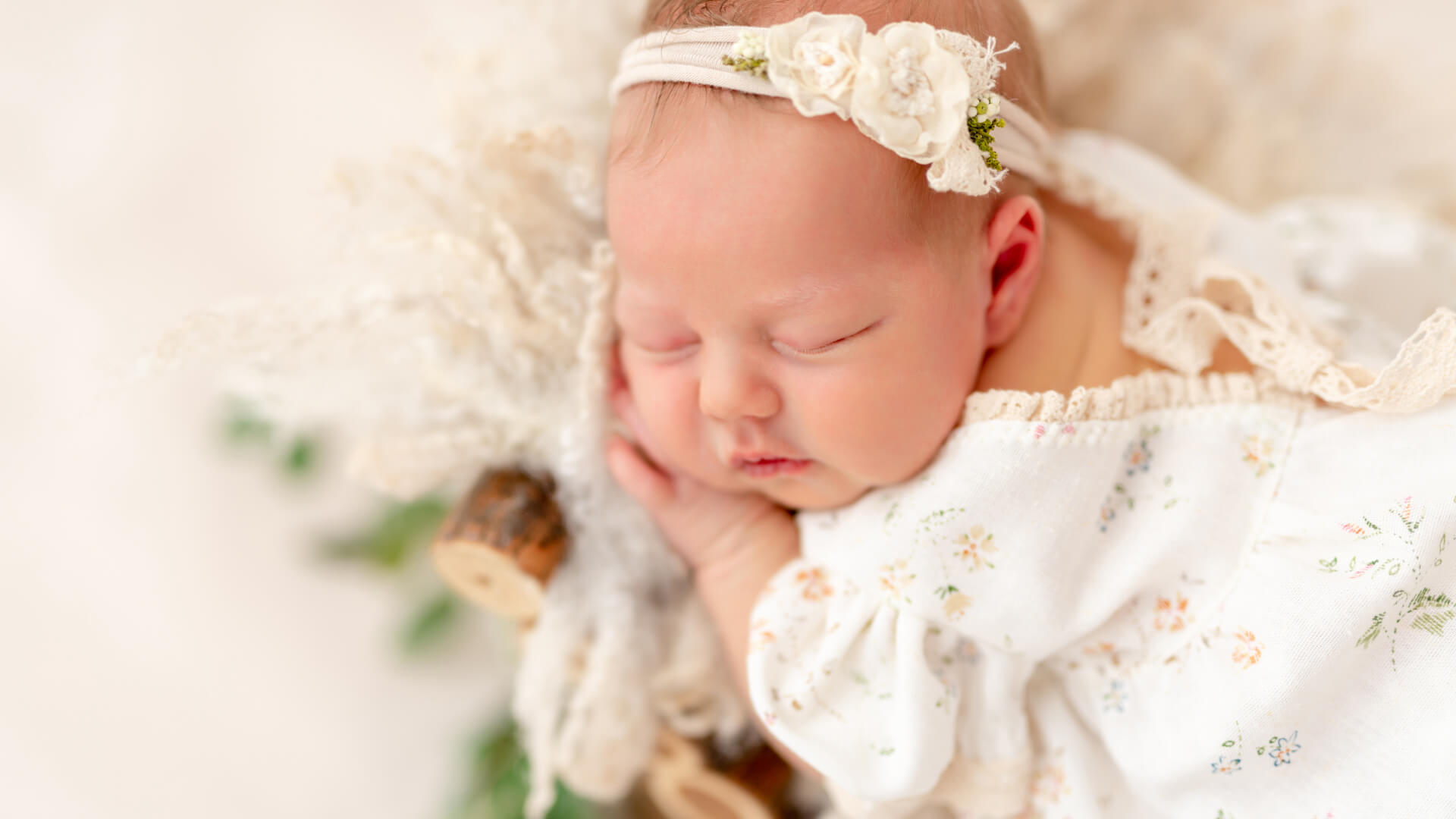-
Published 13 March 2024
-
Updated 27 May 2024

Sleep is one of the most natural states of a healthy newborn. And this is easily explained. For nine months of intrauterine development, the little man was in a cozy and safe environment in direct contact with the most precious creature. And after birth, he suddenly plunged into a completely different world, with its bright light, loud sounds and incomprehensible events. Adapting to a new environment, starting to grow and develop, of course, is easiest in a dream. It's crucial to remember to eat on schedule and to set up all the necessary circumstances for restful sleep.
The three safest sleeping positions are on the back, side, and stomach for both adults and children, respectively. Together, we may attempt to determine which will be best for a newborn.
Safest Sleeping Position for Newborn Babies: On the Back
According to recent studies, it is preferable for neonates to sleep on their backs. Sleeping on your back, according to scientists, dramatically lowers your risk of SIDS (sudden infant death syndrome).
However, the baby's head should really be turned on its side. And even when the baby does not know how to turn over yet, it is better to put something soft to fix the position.
To avoid deformation of the skull, turn the baby's head in the other direction for each dream (it is better to record this, or, for example, notice it by hanging the toy on a clothespin on the appropriate side of the cradle or crib).
If the baby falls asleep better on his side, you should not retrain him. Simply wait for him to go off to sleep, and then gently flip him onto his back while tilting his head to the side.
The Importance of Back Sleeping for Newborns
When the baby sleeps on his back, his head should be turned to the side. Sleeping a newborn on his back is both useful and dangerous. It is useful because it is physiological, natural for him. It is dangerous because it is a baby. In the position on his back, he can choke on regurgitated masses.
Recommendations:
- When placing a newborn on its back, the head should be turned to the side and fixed with a diaper roller so that it cannot turn on its own.
- The position of the head should be changed periodically to avoid torticollis.
- To prevent the baby from scratching and waking himself up with pens in this position, it is better to swaddle him. If the baby does not like to lie swaddled, he is nervous, then it is recommended to put him, for example, on his tummy.
The back position is not recommended if the baby is diagnosed with hip dysplasia, if he has signs of muscle hypertonia (he will constantly pull the handles, preventing himself from sleeping), as well as colic (with abundant gas formation, the newborn will not be able to sleep soundly).
Unsafe Sleep Positions for Babies
We have already found out what is the ideal sleeping position for a baby, let's look at the remaining options that are considered unsafe
Babies Sleeping on Their Stomach
The most harmful position to sleep is on your stomach, as several studies conducted by modern specialists have demonstrated. For infants, who are unable to turn over on their own, this is especially true. Sleeping on your stomach increases the chance of abrupt newborn death by eighteen times, according to data. It is this sleeping position of the child in the case of regurgitation that can lead to suffocation by the masses separated from the pharynx, since in this case the trachea will be located below the esophagus. As a result of this positioning, the regurgitated mass can enter the respiratory tract under the influence of gravity.
Also, while sleeping face down, the baby's nose may stick into the surface of the crib. In this case, respiratory arrest may occur. Another threat is obstructed air circulation. Carbon dioxide accumulates around the head of a baby sleeping on his stomach, which he continues to inhale, oxygen starvation develops. Furthermore, the infant develops his musculoskeletal system, strengthens his muscular corset, and learns how to hold his head while lying on his stomach. For as long as feasible, experts advise placing a crumb on your tummy while you're awake. However, you should never leave the infant alone during this time.
However, it is not necessary to completely abandon the position on the stomach. It contributes to a better discharge of gases. In addition, while on his stomach, the baby learns to hold his head, strengthens his muscular corset, and develops the musculoskeletal system. Experts recommend putting a crumb on your stomach during the waking period for as long as possible, but also during this period do not leave the child unattended.
Babies Sleeping on Their Side
There is an opinion that it is better to put infants on their side. This position is especially recommended after feeding, as the baby may regurgitate in a dream. And if at this moment he is lying on his side, the contents will be on the diaper and will not enter the respiratory tract.
But experts have refuted this, yet the best sleeping position for a baby is on its back with its head turned to the side
Occasional Unsafe Sleep Positions for a Baby
Even brief or infrequent side- or stomach-snoozing is dangerous. According to the NIH, babies who are accustomed to sleeping on their backs, but who are then placed on their stomachs or sides to sleep—maybe by a grandparent, babysitter, or daycare worker—are at a “significantly higher risk” for SIDS than other babies.

Age-Appropriate Sleep Positions for Infants
The position of the newborn during sleep is quite easy to control. If you put him on his back, he will most likely stay in that position. However, there comes a point when you can no longer control your child's position during sleep. He or she may start rolling over at night, which means you won't be able to make sure he stays on his back. So, when can you stop losing sleep over this problem? And at what age is it safe to put a baby on your tummy?
Baby Sleep Positions: Before 12 Months
Between the ages of one and four months, there is an increased risk of SIDS. It is imperative that your infant sleeps in the supine position—flat on their back—during this time. Your baby may turn from her back to her belly at night after she learns to roll over, which normally happens around the age of six months. In this scenario, you should still put your baby to sleep on her back, but if she turns over on her own when you're not there, you shouldn't be concerned. (Once more, remember to keep any flimsy items out of the crib.)
Until your child is around a year old, there is still a chance of SIDS. You should always put your infant to sleep on his or her back until that time. After that, it's likely that you won't be able to regulate how your kid sleeps, so feel free to let them do as they like.
Transitioning to Safe Sleep Positions After 12 Months
By the time they are 12 months old, newborns acquire the motor abilities necessary to move and change positions as they sleep. Although it is still advised that newborns sleep on their backs, parents do not need to worry if their child turns over onto their stomach. Babies are allowed to experiment with several sleeping positions at this age and select the one that feels most comfortable for them.
It's critical that parents are aware that their child's risk of SIDS dramatically declines after the age of one year. To reduce any possible hazards, it is still essential to provide a safe sleeping environment for the infant.
The safe sleep habits recommended for younger babies can still be followed by parents, including using a firm mattress, clearing the sleep area of soft items and loose bedding, and making sure the baby's sleeping space is kept far from the adult bed. It's also crucial to keep an eye on the infant as they sleep to make sure they're safe.
5 Tips for Baby Sleep Safety
One of the most important things a parent can do to ensure their baby's safety is to establish a regular bedtime routine. They might easily be at risk of SIDS, or sudden infant death syndrome, with one incorrect motion. Even though many experts are still baffled by SIDS, it is usually linked to unexpected death while sleeping.
Avoid Co-Sleeping (But Bring Your Baby Into Your Room!)
It is not advisable for infants to share a bed with their parents, siblings, or even their twin. The risk of SIDS may rise if the infant and caregiver share a bed. Your arms, breast, or clothing may unintentionally cover your baby's face while they are sleeping, smothering them. Since it's convenient to nurse a baby at night in India, co-sleeping with the infant is the norm. But now that you know, you can prevent it!
The crib for the child has to be set up in the parent's room. It facilitates nursing and makes it simple for parents to monitor their baby's sleeping postures. The American Academy of Pediatrics (AAP) advises against bed sharing in order to promote baby sleep safety.
Choose A Firm Mattress For Your Baby
You want to get an extremely firm baby mattress as opposed to an adult mattress. A baby's ability to obtain a good night's sleep is greatly aided by having a firm mattress to sleep on. Since babies sleep for extended periods of time, it's important to provide them a firm mattress that will support them during the night. The risk of SIDS can be raised by providing room for newborns to turn over and suffocate on soft sleeping surfaces. Although it might not seem so, a firm mattress is really rather comfy. The back support and shaping that adult bodies require is not necessary for babies.
There are many different features and pricing points available for crib mattresses. You might be able to save money by getting a foam mattress for your crib, as babies usually only use it for a few years. Before making a purchase, place your hand in the middle of the mattress to test it. An imprint should appear, but it should disappear as soon as you remove your hand.
Monitor Your Baby's Environment
There should be no blankets, no toys or anything else for that matter apart from their mattress. These objects provide a risk of suffocation when placed in the crib. Simply clothe your kid warmly if you want to keep them toasty on a chilly day.
Stay Up To Date With Immunizations
Immunizations aid in the prevention of dangerous illnesses such whooping cough, polio, and measles. You lower your chance of getting these illnesses and any consequences by adhering to your vaccination regimen.
Give Your Baby A Pacifier
According to a number of studies, babies who slept with pacifiers in their last sleep had a far reduced chance of suffering SIDS than babies who didn't. The results of a recent meta-analysis supported the notion that pacifiers can prevent SIDS. Although the precise mechanism underlying this protective effect is unknown, one possibility is decreased sleep arousal thresholds. The AAP Task Force advises parents and other caregivers to think about using pacifiers while putting infants to sleep if they are younger than a year old. When a baby declines to accept a pacifier, parents and other caregivers should provide it to them rather than forcing them. After the baby falls asleep, pacifiers should not be put back in; instead, they should be dry and clean. When introducing a pacifier to a breastfeeding newborn, parents should wait until the child is one month old or until the nursing bond is formed.
It may be useful for you: Best Pacifiers for Newborns.

FAQs
What is the best sleeping position for my baby?
The infant should be put to sleep on their back as this is the first and most crucial thing to do. Body alignment and posture are crucial in protecting the unborn child from unanticipated hazards.
Why is it important to put my baby to sleep on their back?
Up to the time of her first birthday, you should always place your baby to sleep flat on her back on a sturdy, level surface for naps and nighttime. Babies who sleep on their stomachs are more likely to suffocate or overheat and are also at risk for SIDS.
It's okay to let your baby to continue sleeping that way as long as she can roll over on her own from her stomach to her back and back to her stomach. Usually, babies can roll over between three and six months, but it might happen sooner or later, so pay special attention to her development.
If it seems like your newborn has rolled onto her side, that’s probably her reflexes at work. She’ll likely lose the ability to do that by the time she’s a month old.
Can I use Bed Sharing
Having your baby sleep in your room for the first six months can help lower the risk of SIDS by up to 50 percent. And of course, keeping her nearby makes for easier nighttime feedings if you're breastfeeding.
But you should avoid cosleeping (letting your baby sleep in your bed), says the AAP. Always keep her in her own bassinet or crib, since your bed's pillows and blankets could pose a danger. And there are the added risks of baby falling off the bed and of someone accidentally rolling onto her overnight.
How can I encourage my baby to sleep on their back?
In the first months, when putting your baby to sleep, always put him on his back. There should be no plastic or plush toys, pillows or napkins in the bed, so that nothing gets into the child's mouth and the respiratory tract remains clean. Your child only needs a blanket. Active infants who move especially a lot and tend to pull blankets over their heads are recommended to sleep in baby sleeping bags. To avoid the development of body asymmetry or head displacement, regularly move the bed to another place, because children always turn their heads in the direction from which voices and light come.
How to Change Baby Sleeping Positions
Getting your baby to stick to sleeping on their back once they have tried sleeping on their front might be difficult, but is made easier if your baby is always put down to sleep whilst awake rather than allowing your baby to fall asleep in your arms. Keep going, they will eventually get used to it.










